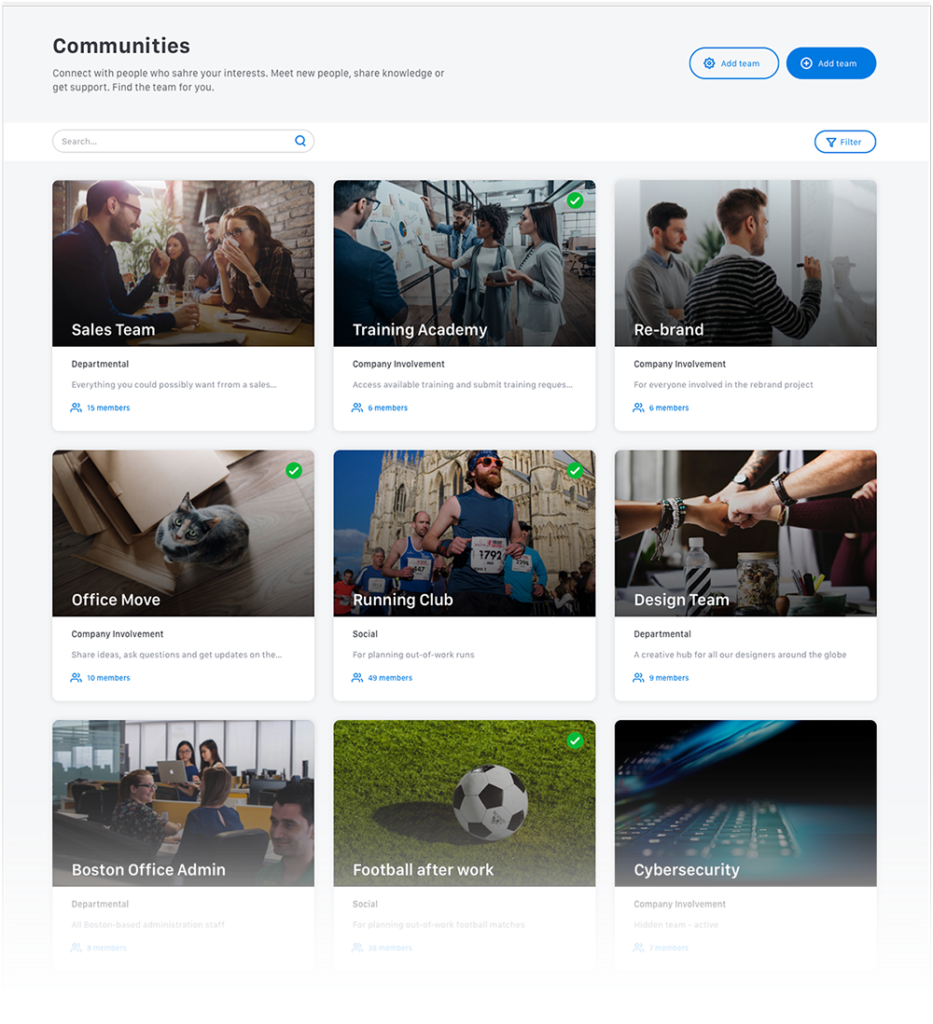How much has remote work changed recently? Here are some figures to ponder on:
- The time spent by employees and managers in collaborative projects has increased by 50% or more in recent years.
- More than 40% of U.S. workers were working full-time from home as of June 2020.
- CEOs, on average, estimate 36% of their employees will be working remotely by January 2022, compared to just 13% before the pandemic.
Remote work comes with its advantages: low or no office expenses, flexibility, and a massive pool of applicants to hire. However, keeping your remote team working together efficiently and on the same page can be a considerable challenge.
To reduce the amount of work and help workers maintain a healthy work-life balance, you need to find ways for your teams to collaborate remotely. Before we see how technology can help remote teams collaborate better, let’s look at the challenges remote teams face.
Remote working has its own set of challenges
Productive collaboration is imperative for high performance. However, how do you maintain a culture of collaboration if your workers are not in the same place? Here are some challenges that come with remote working.
- Team communication and collaboration issues
Despite the presence of videoconferencing apps such as Zoom, remote working renders visual and verbal cues harder to detect. The lack of these subtle signals can make it easier to misinterpret what team members are trying to say.
Supporting meaningful DE&I with a modern intranet
Professionals that work in customer services, management, sales, and other areas where collaborative and impromptu interactions are vital may be particularly challenged in this aspect. They might be looking for the convenience that comes with being able to walk up to your colleague and talk or share ideas.
Also, since all your team members may not work in the same location, there’s a high chance that things will not be communicated adequately.
- Not Being Able to Unplug
In previous years, communication and collaboration were the biggest problems that remote workers faced. However, a recent survey showed that remote workers’ biggest struggle nowadays is the lack of ability to unplug from work.

When your living and work areas are near each other it becomes difficult to distinguish between your personal life and your work. Establishing a healthy work-life balance becomes a challenge. If nothing is done to ensure your staff maintains that healthy work-life balance, it can lead to burnout within your team.
- Loneliness
Working from home causes a lack of social interaction, leading to more isolation and loneliness. This feeling of isolation affects your team’s physical and mental well-being. As a result, productivity often drops, which has a knock-on impact on business performance.
A new study by the American Psychological Association found that lonely people are more likely to develop depressive symptoms. These individuals are less likely to help their colleagues or complete deliverables on time, affecting your team’s overall morale.
How can technology help boost remote team collaboration?
New digital collaboration tools have emerged in response to corporations with remote or hybrid workplaces. While professional emails remain one important way of communicating internally and externally, you may use other tools to streamline your team’s operations and promote collaboration.
- Effective team meetings via video conferencing and chats
With remote work rising, it’s only natural that businesses resort to more video conferencing to keep communication effective. As we’ve seen earlier, remote jobs come with their challenges, but let’s see the benefits that video conferencing brings to your business.
Employee isolation can significantly affect productivity, and even though audio conferencing can be helpful, it’s not as engaging as video conferencing. Video conferencing and chat can make employees feel connected, valued, and heard.
When your team members can see each other, they may feel more comfortable working together. If your employees live in different time zones, video conferencing is also one of the most efficient ways of introducing team members to each other.
- Apps for team collaboration to increase engagement
Employee engagement is vital for the growth of your business, and here’s why.
Whatever the size of your business, employees are the cornerstone of your company. Keeping them engaged is a crucial factor in the success of your business. Besides, it’s much cheaper to keep your employees engaged than to hire a new employee to replace someone who has left your company.
Employee engagement is a vital measure of what’s going on internally in your company.

Engaged employees commit to qualify and provide a better customer experience. Furthermore, higher engagements also mean higher productivity.
4 Types of employee engagement apps
Most people think that employee engagement apps are survey apps, but that’s only one type of employee engagement app. Here are the four kinds of engagement app:
- Recognition apps
- Feedback apps
- Data collection apps
- Communication apps
Feedback apps such as 15Five give you the chance to find out how your employees are doing every week. Most of these apps are designed to keep communication open between managers and team members. That can help you get helpful feedback that management needs.
Communication apps such as Slack and RingCentral can help you keep them engaged and connected. The right communication tool isn’t just to give employees a way to chat and send memes. Keeping them connected in a variety of methods can improve your company. For example, tools like Zoom and RingCentral allow you to chat, make video calls, and share screens.
Web-based tools like Gather, on the other hand, enhance the remote working experience by simulating the office environment. It features many real-life aspects of working in an office, including customizable spaces, huddle rooms, and office pantries. Your team may even visit a virtual private island if you feel like going offsite for a day.
Recognition apps are excellent for sharing issues and developing fresh ideas in the company. You can also use these apps to celebrate team accomplishments.
Data collection apps help you get quantifiable evidence of where your employee engagement stands. These apps keep employee data confidential while allowing you to gather data related to worker sentiment.
Supporting meaningful DE&I with a modern intranet
- Tools for project management for an organization
While project management is a well-defined profession with its own set of certifications, your team members might lead projects even without much project management experience. For instance, if you’re working on a creative project, you need to define tasks and assign designers to them.
While you only need a checklist for simple projects, complex ones require features that allow you to plan, set deadlines, assign and track tasks, and ensure the completion of deliverables. That’s where scheduling software and project management tools come in handy. Here are some project management tools you can implement in your team.
ProofHub
ProofHub is an all-in-one collaboration tool that reduces the need for specialized apps for project management. ProofHub’s latest release is excellent for remote teams, including outsourced projects, because it’s completely cloud-enabled.
That means you can sign in to a project management tool for all your project needs.
Asana
Asana is an online team collaboration tool that focuses on workflow management. It contains workflows that recur tasks automatically. The app makes it simple to track your project in great detail and shows what’s happening to the team.
In terms of workflows and tasks, Asana is an elegant and flexible tool. It can make managing your projects easier.
- Use the proper tools to collaborate successfully
If you want effective remote team collaboration, you need to use the right tools. The various collaborative tools discussed in this guide can help your business succeed, whether big or small.
For example, Monday is a team management platform that centers on fostering team collaboration and building transparency. It helps team members see how each one is doing with their tasks and offers help when needed.

You can use different collaborative tools together to derive the most benefits. This creates an ecosystem that your team can use to achieve a common objective. However, your team needs to agree to a limited number of tools since too many of them can leave them confused and overwhelmed.
Supporting meaningful DE&I with a modern intranet
- Using an intranet as a social framework
For many companies, a social intranet is at the heart of how they maintain a collaborative company culture.
When used to create a social environment for remote workers, intranet software can unite employees whether they’re based in one office or spread across several continents. It can be an internal hub for staff to speak to each other and to share knowledge.

Features that enable the creation of user-generated content and communities, including forums and discussion groups, bring people together virtually and encourage employee engagement and collaboration. For remote-worker collaboration, social features such as this are important because they can stimulate spontaneous idea-building and create a more positive employee experience.
Wrapping Up
Remote team collaboration is essential for your team to succeed. But developing and maintaining a remote collaborative environment can be a challenge.
You can help them by taking some time to meet them one-on-one and learn about what’s going on in their lives. Then, maybe you can offer words of encouragement or congratulate them, whatever is appropriate. Through remote working and collaboration tools, you can keep your team members motivated and ready to face the next challenge.
These tools include remote project management tools that help track task progress and let you assign activities to specific team members. They also have tools such as Zoom that make communication more accessible and convenient. You may also use these tools for employee recognition and engagement activities, keeping your employees safe while building and maintaining ties within your team.
Supporting meaningful DE&I with a modern intranet
Contributor:
Owen Baker is a content marketer for Voila Norbert, an online email verification tool.


